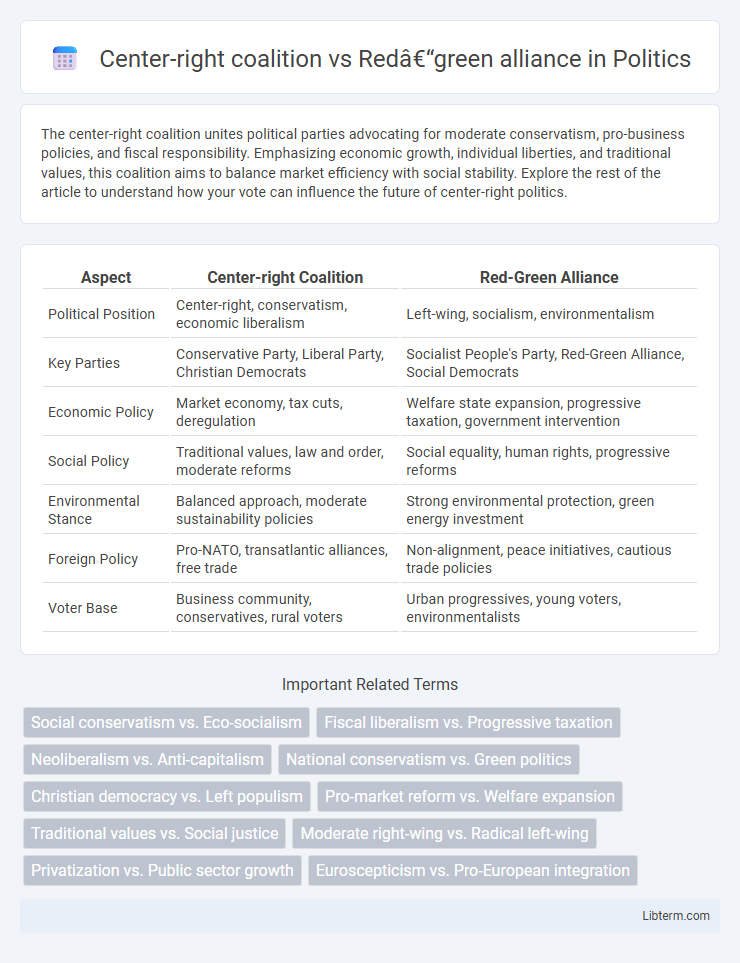The center-right coalition unites political parties advocating for moderate conservatism, pro-business policies, and fiscal responsibility. Emphasizing economic growth, individual liberties, and traditional values, this coalition aims to balance market efficiency with social stability. Explore the rest of the article to understand how your vote can influence the future of center-right politics.
Table of Comparison
| Aspect | Center-right Coalition | Red-Green Alliance |
|---|---|---|
| Political Position | Center-right, conservatism, economic liberalism | Left-wing, socialism, environmentalism |
| Key Parties | Conservative Party, Liberal Party, Christian Democrats | Socialist People's Party, Red-Green Alliance, Social Democrats |
| Economic Policy | Market economy, tax cuts, deregulation | Welfare state expansion, progressive taxation, government intervention |
| Social Policy | Traditional values, law and order, moderate reforms | Social equality, human rights, progressive reforms |
| Environmental Stance | Balanced approach, moderate sustainability policies | Strong environmental protection, green energy investment |
| Foreign Policy | Pro-NATO, transatlantic alliances, free trade | Non-alignment, peace initiatives, cautious trade policies |
| Voter Base | Business community, conservatives, rural voters | Urban progressives, young voters, environmentalists |
Defining Center-Right Coalition and Red–Green Alliance
The Center-right coalition in Denmark primarily comprises the Liberal Party (Venstre), the Conservative People's Party, and the Liberal Alliance, emphasizing market liberalism, fiscal conservatism, and individual freedoms. The Red-Green Alliance (Enhedslisten) represents a left-wing political bloc committed to socialism, environmental sustainability, and social justice. These entities define opposing ideological spectrums in Danish politics, with the Center-right coalition advocating for economic growth through private enterprise, while the Red-Green Alliance prioritizes public sector expansion and progressive environmental policies.
Historical Origins of Each Political Bloc
The Center-right coalition in Denmark originated from conservative and liberal parties dating back to the 19th century, rooted in principles of free market economy, individual rights, and gradual reform. The Red-Green Alliance, established in 1989, emerged from the merger of left-wing socialist, communist, and environmental groups advocating for social justice, workers' rights, and sustainable policies. Both blocs evolved through Denmark's political landscape reflecting distinct ideological responses to industrialization, welfare, and globalization challenges.
Core Ideologies and Policy Priorities
The Center-right coalition emphasizes free-market capitalism, fiscal conservatism, and limited government intervention, prioritizing economic growth, tax cuts, and strengthening national security. The Red-green alliance focuses on social democracy, environmental sustainability, and welfare state expansion, aiming to enhance social equality, climate action, and public services. Both coalitions reflect contrasting approaches to governance, with the Center-right leaning towards market-driven solutions and the Red-green advocating for state-led reforms and green policies.
Key Parties and Their Leadership
The Center-right coalition in Denmark primarily features the Venstre party led by Jakob Ellemann-Jensen and the Conservative People's Party under Soren Pape Poulsen, emphasizing liberal economic policies and fiscal conservatism. The Red-green alliance is anchored by the Social Democrats with Mette Frederiksen as their leader, supported by the Socialist People's Party and the Red-Green Alliance, advocating for social welfare expansion and environmental sustainability. These parties' leadership styles directly influence their strategic priorities and coalition dynamics within the Danish Parliament.
Economic Approaches: Market vs. Welfare
The Center-right coalition prioritizes market-driven economic policies, emphasizing deregulation, tax cuts, and incentives for private enterprise to stimulate growth and competitiveness. The Red-green alliance advocates for a welfare-oriented economy, focusing on wealth redistribution, robust social safety nets, and increased public spending to reduce inequality and promote social justice. These opposing economic approaches shape tax policies, labor market regulations, and government intervention levels in each coalition's governance strategy.
Environmental Policies and Sustainability Views
The Center-right coalition generally promotes market-driven environmental policies, emphasizing innovation, economic growth, and gradual sustainability measures, often prioritizing energy efficiency and the reduction of emissions through technological advancements. In contrast, the Red-green alliance advocates for more aggressive climate action, focusing on renewable energy adoption, stricter regulations on fossil fuels, and social equity in environmental policies to achieve comprehensive sustainability and carbon neutrality goals. These differing priorities reflect contrasting approaches to balancing economic development with environmental responsibility.
Social Issues and Cultural Stances
The Center-right coalition emphasizes traditional family values, stricter immigration policies, and a market-oriented approach to healthcare and education, promoting individual responsibility and national identity. The Red-green alliance prioritizes social equality, multiculturalism, and expansive welfare programs, advocating for LGBTQ+ rights, gender equality, and progressive immigration reforms. These contrasting stances highlight a fundamental divide on social inclusion, state intervention, and cultural preservation within the political landscape.
Recent Electoral Performance and Public Support
The Center-right coalition secured a plurality in the most recent parliamentary elections, gaining 40% of the vote compared to the Red-green alliance's 35%, reflecting steady voter preference shifts in suburban and rural areas. Public support for the Center-right coalition has been bolstered by economic policies promoting market liberalization and tax reforms. Conversely, the Red-green alliance maintains strong backing in urban centers, driven by environmental initiatives and social welfare programs.
Coalition Building and Government Formation Strategies
The Center-right coalition employs strategic partnerships among liberal-conservative and Christian-democratic parties to secure majority support through negotiated policy compromises and shared leadership roles. In contrast, the Red-green alliance emphasizes collaboration between social-democratic and green parties, prioritizing progressive policy agendas and environmental sustainability to attract left-leaning voters and consolidate parliamentary influence. Both coalitions utilize targeted voter base expansion and inter-party agreements to optimize government formation under proportional representation systems, balancing ideological cohesion with pragmatic governance.
Future Challenges and Political Outlook
The Center-right coalition faces future challenges in addressing economic growth while balancing fiscal austerity with social welfare reforms, impacting voter confidence and policy stability. The Red-green alliance must navigate environmental sustainability demands alongside expanding social equity, positioning itself amid rising climate activism and urban-rural divides. Political outlook for both blocs hinges on adapting to demographic shifts, digital transformation, and evolving international dynamics influencing domestic agendas.
Center-right coalition Infographic

 libterm.com
libterm.com